Dog dies of heat stroke after riding with owners in air-conditioned SUV
What began as a drive to meet a dog at a rescue ended in tragedy when a beloved family pet died of heat stroke.
The owners had driven with the dog inside an SUV with the air conditioning on and the windows cracked.
Now, the veterinarian who treated the dog is warning other pet owners to take extra precautions.
Heat stroke despite air conditioning
It started as a hot but happy summer day for Bruno and his owners in Ohio as they headed to a meet-and-greet to adopt another dog.
But Sugarcreek Veterinary Clinic owner Dr. Brandon Michels said it went horribly wrong.
"Bruno suffered a heat stroke from essentially being inside of a vehicle, even though that vehicle was running and had the air conditioning on, due to the extreme temperatures outside that day," Michels said.
By the time Bruno arrived at Michels' practice, it was too late. The four-year-old Newfoundland had been riding in the backseat of the SUV. Michels said dogs with long hair or double coats, like Bruno, are more susceptible to overheating.
"In a larger vehicle, you don't necessarily have fans that are circulating that air. Most of the time, those fans are located in the front of the vehicle," he said.
Warning signs of heat stroke
Michels said early signs of heat stroke in dogs include panting, dry gums and excessive drooling.
"In more severe cases, some of the things you're going to see are trembling or drunkenness," he said. "That can then progress to vomiting and diarrhea."
To help keep pets safe, Michels recommends cooling vests, frozen treats, and always having cool water and a bowl on hand. He also suggests pet-specific air conditioning units that can direct airflow to the back of a vehicle.
Know your vehicle's airflow
"Let the vehicle run for a little bit before you get in," said Art Munoz, chief government relations officer with Operation Kindness, a no-kill shelter in Carrollton. "Understand your vehicle, understand how your AC works — whether the circulation is better up front or toward the back — and just make those accommodations for your pets."
Operation Kindness works with Dallas Animal Services to investigate hot car cases.
"Every year we get the calls—multiple calls a year—not only in the city of Dallas, but cities all over Texas," Munoz said. "The good thing is, we haven't had any fatal cases as of now because we always advocate for people to call 911 or local animal control."
Protect paws from hot pavement
Munoz also urged pet owners to be mindful of hot pavement.
"It is 10, 15, 20 degrees hotter," he said. "So always take those precautions, whether that's booties or early morning and late evening walks."
Rescue group updates protocols
Bruno's family had been en route to Life and Rescue with the Reeds when the tragedy occurred. The rescue group has since implemented new protocols to prevent similar incidents:
- Transport routes are limited to 1.5–2 hours
- AC must be on the coldest setting
- Front vents must be directed toward the back
- All transporters are in a group chat with rescue leadership
- Water must be in the vehicle
- Zoom training on heat stroke signs is required
- Emergency vet visits are mandatory if symptoms appear
- Sugarcreek vets are available for consultation
- Temperature gauges are being added to vehicles
- Transports are canceled on very hot days unless it's an emergency
- Early morning transports are now standard
- Battery-operated fans and solar-powered AC units are being considered
- Dogs are no longer allowed in the very back of vehicles
- Hammock-style seat covers are discouraged if they block airflow
- Cooling vests are being purchased for transported dogs




